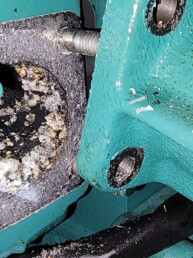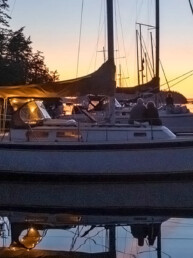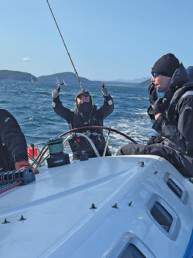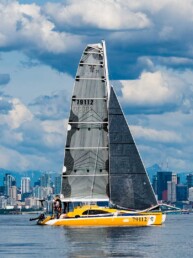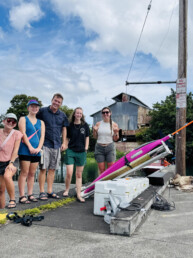Cruising this seldom visited fjord might be more accessible than you think
In over 20 years of sailing out of the Port of Brownsville, Washington, we had not ventured into Hood Canal. Though we live near Hood Canal’s Seabeck Bay and frequently walk sections of the shoreline, our cruising plans for these waters never progressed beyond, “maybe someday.”
In the spring of 2018, we finally put Hood Canal on our summer sailing list to anchor in Seabeck Bay for a week. Basing the boat from there, we planned day trips because our elderly dog, Bailey, was homebound and needed a lot of extra care. It was a good compromise, as it allowed us to do some Canal exploring and be home enough to meet Bailey’s needs.
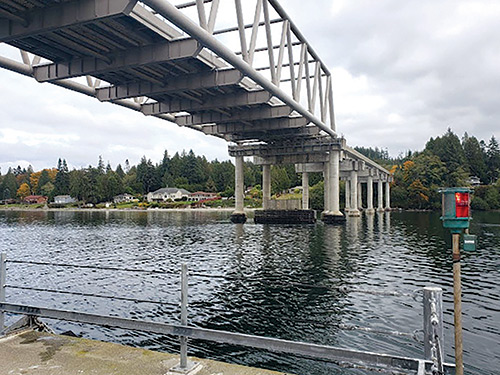
The Hood Canal Bridge stands sentry at the mouth of these unsung cruising grounds, and any passage into Hood Canal requires transiting past the bridge. I wasn’t comfortable with what the navigation charts indicated was a clearance of 50 feet under the eastern truss at all tide levels. Our Beneteau 31 Encore’s sloop rig has the air draft (mast height above designed waterline) listed at 47 feet. Added to that height is an anchor light, anemometer and VHF antenna. Such tight clearance led me to call the Hood Canal Bridge one week ahead of our trip to Seabeck to arrange for openings both north- and southbound.
Anyone who has driven highway 104 may be familiar with the huge traffic backups caused by a single bridge opening, and we had seen them firsthand on numerous occasions. As soon as our openings were booked, I began thinking about the impact our transit would have on so many other travelers. Though for our 2018 journey into Hood Canal we kept our scheduled draw span openings, seeing the traffic jam from the water motivated me to look more deeply into the possibility of passing under the eastern truss of Hood Canal Bridge, which would not require stopping traffic, for any trips in the future.
There are two places to go under this bridge. On the west end, the clearance is 35 feet and too low for most sailboat transits. The eastern truss, on the Kitsap side, is unlike any other bridge we go under in the Pacific Northwest. Looking closely at the bridge structure, I realized pilings at one end float with the tide. Pilings on the other end are fixed to shore. Nautical charts treat it as a fixed clearance bridge. In 2009, the bridge’s eastern fixed and floating spans were replaced. Clearance under the truss was lowered by 5 feet. Notations on up-to-date nautical charts show the eastern truss has a fixed clearance of 50 feet at all tide levels. This clearance reduction limits the number of vessels that may safely pass under the truss, and requires draw span opening for many sailboats in the 30- to 35-foot range.
When I spoke with Doug Adamson, a communications consultant for the Washington State Department of Transportation (WSDOT), he pointed out that marine traffic has priority over road traffic, but only if a vessel can’t fit under the truss. Adamson noted that WSDOT is also keen on minimizing the number of bridge openings, as are land drivers. Rightfully so, they request that all skippers be certain their rig is too tall to go under the truss before calling for a draw span opening.
With a better understanding of how Hood Canal Bridge clearance changes with tide level, the number of draw span openings can be reduced along with traffic delays for both sailors and drivers. Since one end of the truss floats, that means there is extra clearance near shore at low tides. Good old high school trigonometry comes into play; the tangent function in case you’re curious. Based on chart notation alone, skippers may ask for an opening of the draw span when their vessel has an air draft nearing 50 feet. But a draw span opening could be avoided if the skipper passes Hood Canal Bridge at low tide.
Vertical Clearance and Tide Level
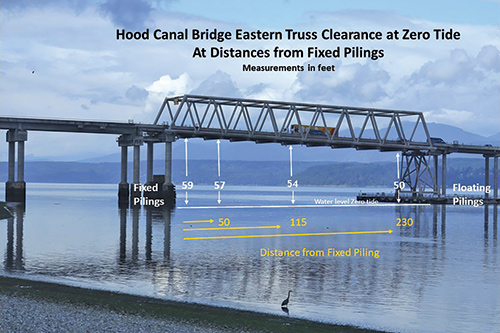 At a zero tide, Hood Canal water level drops 9.4 feet below the “mean high water” (or MHW, which is the average of all the daily high tide levels observed over an extended period of time). When the tide is at zero, the floating end of the truss retains its clearance of 50 feet; meanwhile, at the eastern shore side with fixed pilings, the vertical clearance has become 59 feet. Sailors must be cautious — there may not be enough water draft for maneuvering a sailboat hard against the shore.
At a zero tide, Hood Canal water level drops 9.4 feet below the “mean high water” (or MHW, which is the average of all the daily high tide levels observed over an extended period of time). When the tide is at zero, the floating end of the truss retains its clearance of 50 feet; meanwhile, at the eastern shore side with fixed pilings, the vertical clearance has become 59 feet. Sailors must be cautious — there may not be enough water draft for maneuvering a sailboat hard against the shore.
Fifty feet from shore, there is more water depth and the bridge deck has dropped only 2 feet, giving a vertical clearance of 57 feet. At mid span, 115 feet from shore, the bridge deck drops 5 feet giving a vertical clearance of 54 feet at zero tide.
Water depth under the truss at “mean lower low water” (or MLLW, which is the average height of the lowest daily tide recorded at a tide station) is about 20 feet, based on e-charts and 7 fathoms on printed charts. WSDOT says the passage is periodically dredged to 30 feet ensuring adequate depth for Navy support vessels that fit under the truss.
Before 2009 when vertical clearance was 55 feet, the skipper of a Pearson 34 would have been comfortable sailing under the truss at any tide level with an air draft of 47 feet, 3 feet of equipment on top of the mast, and a water draft of 6 feet. In 2023, with the updated vertical clearance of 50 feet as reflected in the latest editions of the relevant charts, the skipper would assume an opening of the draw span is necessary. By approaching the bridge at a zero tide and sailing under the truss 50 feet off the eastern shore, the vertical clearance is 57 feet and opening the draw span is not needed.
For comparison, the Port Townsend Canal Bridge has a vertical clearance of 58 feet at MHW and a horizontal clearance of 236 feet.
Arranging a Draw Span Opening
Should a skipper need to arrange a draw span opening, the bridge operators would like a few days’ notice. Then, they want you to call about an hour before arrival. At this point, the bridge operators will work you into other marine traffic approaching the draw span. Keep in mind, you may be asked to wait for an hour or more so additional marine traffic can use the same opening.
At the start of the opening process, you will be asked to do three things: Come as close to the draw span as your comfort level allows. Pass through the span when it is open enough for your vessel to proceed — no need to wait for a complete opening. Lastly, call the bridge operators on channel 13 when you are clear to allow the closing process to start.
It takes only 30 seconds to pass through the draw span, but road traffic is halted for about 30 minutes. If a submarine is sharing your opening of the span, you will be kept at a secure distance determined by armed escort vessels.
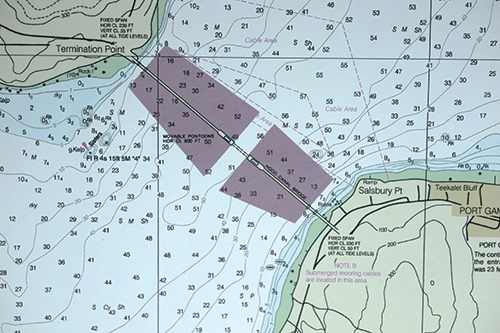
A Worthwhile Destination
Though Hood Canal can seem inaccessible to some cruisers because of the bridge, it’s worth the effort to make it here. Close to Port Townsend and Port Ludlow, and relatively near Seattle, this fjord is set hard against the Olympic Mountains. Cruisers who venture south of the bridge usually find they have a vast expanse of water all to themselves, with some stunning surroundings. A review of cruising guides indicates skippers can explore options ranging from primitive DNR tidelands and quiet bays, to state parks and marina resorts.
Back in 2018, after passing southbound through the draw span of the Hood Canal Bridge, our 16 nautical mile journey from there to Seabeck was pleasant and mostly uneventful. Along the way, we encountered Naval Base Kitsap Bangor Submarine Port on the eastern shore. Signage, fencing and patrol boats make it very clear all vessels are to give the facility a wide berth. There was an exercise taking place near mid-channel, so we contacted a nearby security vessel on channel 13 to determine how best to stay out of their way.
Arriving at our homebase in Seabeck, we settled in, relaxed, and had plenty of opportunity to return to the house to care for Bailey. In the following days, we ventured out from Seabeck, exploring north into Dabob Bay, west to Pleasant Harbor, and south to Stavis Bay and Guillemot Cove. We explored just enough of Hood Canal to know that we want to come back. On our next trip, we plan to sail farther south to the Great Bend for stops at Union and Alderbrook Resort.
Truly, Hood Canal should be on every PNW cruisers’ destinations list. And for many boats (including Encore), timing Hood Canal Bridge transit with lower tides and positioning yourself carefully to maximize clearance and water depth, means that the passage can be easy for boats and car traffic alike.
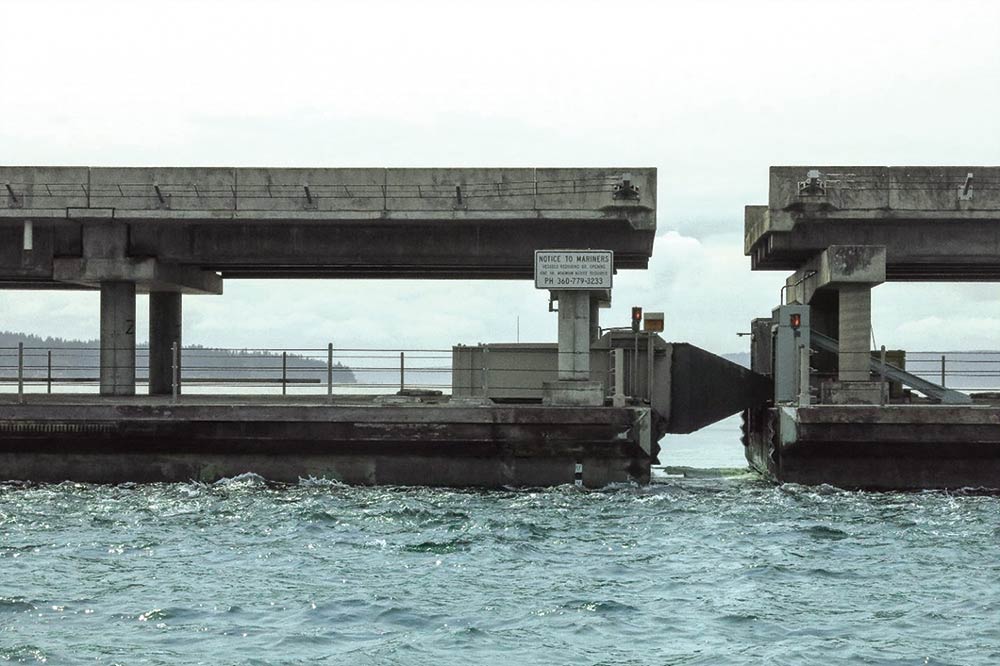
Definitions and data
- Mean High Water (MHW) is used to determine clearance under a fixed bridge. For Hood Canal Bridge it is 9.4 feet based on WSDOT truss drawings.
- Mean Lower Low Water (MLLW) is the reference point for depth soundings. It is 0.0 feet for Hood Canal Bridge based on NOAA datum and WSDOT truss drawings.
Data on Printed and E-Charts:
- Horizontal Clearance: The width of the passage — 230 feet.
- Vertical Clearance: The height of the truss above the water. Charts show this is 50 feet at all tide levels.
Relevant Vessel Data:
- Air Draft: Height to the top of the mast from the designed water line. This dimension is not published for all sailboats. It may be necessary to measure mast height from the deck and the deck height above the water. Adding together both of the measurements will give you the air draft.
- Even if Air Draft is listed for your vessel, it is a good idea to confirm with a measurement.
- Total Air Draft adds any items fixed on top of the mast like lights, antennas and anemometers.
- Note: Between May 22 and September 30 each year, the bridge does not open for recreational vessels between 3 p.m. and
6:15 p.m. - An opening can be arranged by calling 360-779-3233. When in the bridge vicinity, operations personnel can be contacted on channel 13.
After flying airplanes for 15 years, Wendell Crim switched to the vertical wings of sailing. Twenty some years and four vessels later, the learning continues on races and cruises, and retirement now provides more time to take in the wonders of sailing. Feature photo courtesy of Doug Adamson.

